Earth/Geognosy
< Earth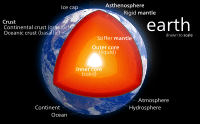
Geognosy is the science and theory of the constitution of the Earth.
Theoretical geognosy
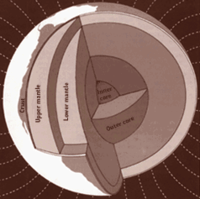
Def. the "geological study of the Earth's structure and composition"[1] is called geognosy.
Geoseismology
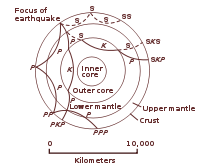
"Evidence from geoseismology, heat flow at the surface, and mineral physics is combined with the Earth's mass and moment of inertia to infer models of the Earth's interior - its composition, density, temperature, pressure. For example, the Earth's mean specific gravity (5.515) is far higher than the typical specific gravity of rocks at the surface (2.7–3.3), implying that the deeper material is denser. This is also implied by its low moment of inertia (0.33 M R2, compared to 0.4 M R2 for a sphere of constant density). However, some of the density increase is compression under the enormous pressures inside the Earth. The effect of pressure can be calculated using the Adams–Williamson equation. The conclusion is that pressure alone cannot account for the increase in density."[2]
"Reconstruction of seismic reflections in the deep interior indicate some major discontinuities in seismic velocities that demarcate the major zones of the Earth: inner core, outer core, mantle, lithosphere and crust."[2]
"The seismic model of the Earth does not by itself determine the composition of the layers. For a complete model of the Earth, mineral physics is needed to interpret seismic velocities in terms of composition. The mineral properties are temperature-dependent, so the geotherm must also be determined. This requires physical theory for thermal conduction and convection and the heat contribution of [radionuclides] radioactive elements. The main model for the radial structure of the interior of the Earth is the Preliminary Reference Earth Model (PREM). Some parts of this model have been updated by recent findings in mineral physics (see post-perovskite) and supplemented by seismic tomography."[2]
Crusts
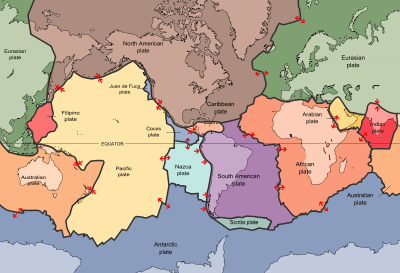
"In geologic terms, a plate is a large, rigid slab of solid rock. The word tectonics comes from the Greek root "to build." Putting these two words together, we get the term plate tectonics, which refers to how the Earth's surface is built of plates. The theory of plate tectonics states that the Earth's outermost layer is fragmented into a dozen or more large and small plates that are moving relative to one another as they ride atop hotter, more mobile material."[3]
Lithospheres
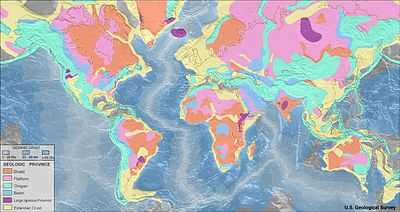
Def. "(cold) electrically resistive, seismically fast material with an anisotropy direction often different from present-day absolute plate motion (APM)"[4] is called the lithosphere.
"Between the crust and the mantle is the Mohorovičić discontinuity.[5]"[2]
"Between 100 and 200 kilometers below the Earth's surface, the temperature of the rock is near the melting point; molten rock erupted by some volcanoes originates in this region of the mantle. This zone of extremely yielding rock has a slightly lower velocity of [seismic] waves and is presumed to be the layer on which the tectonic plates ride. Below this low-velocity zone is a transition zone in the upper mantle; it contains two discontinuities caused by changes from less dense to more dense minerals. The chemical composition and crystal forms of these minerals have been identified by laboratory experiments at high pressure and temperature. The lower mantle, below the transition zone, is made up of relatively simple iron and magnesium silicate minerals, which change gradually with depth to very dense forms. Going from mantle to core, there is a marked decrease (about 30 percent) in [seismic] wave velocity and a marked increase (about 30 percent) in density."[6]
Def. "the depth at which seismic anisotropy direction changes from a lithospheric "fossil" direction to an asthenospheric plate-flow direction parallel to APM"[4] is called the lithosphere-asthenosphere boundary.
Asthenospheres
Def. "the ductile part of the earth"[7] is called the asthenosphere.
Def. "(hot) electrically conductive, seismically slow material with an anisotropy direction parallel to [absolute plate motion] APM"[4] is called an asthenosphere.
"The asthenosphere is about 180 km thick."[7]
"The hypothesis that the Earth has an asthenosphere can be tested by searching experimentally for a layer with physical properties attributable to its low strength. Since the shear modulus of a material reduces as its melting temperature is approached the asthenosphere should retard the passage of earthquake S-waves, whose velocity is directly proportional to the shear modulus of the material through which it is travelling. The presence of a seismological low velocity layer (LVL) or zone (LVZ) near the top of the mantle thus provides evidence for the asthenosphere. The evidence is particularly convincing since S-waves, which are more sensitive to the prevailing shear modulus than P-waves, are slowed down to a greater extent than the latter. The low velocity zone is much better developed under ocean basins than under continental shield areas where it sometimes barely developed. Hence, oceanic lithosphere is much better defined seismologically than continental lithosphere."[8]
Def. an asthenosphere with a "rapid increase in electrical conductivity, at upper mantle depths"[4] is called an electrical asthenosphere.
The oceanic asthenosphere is apparently at a much lower depth than the asthenosphere is detected at beneath continents.
Conrad discontinuity
"While most impact craters are characterised by negative magnetic anomalies over their central regions, aeromagnetic surveys over the Vredefort meteorite impact crater reveal multiple concentric magnetic patterns with no significant anomaly at its centre. [A] prominent negative magnetic anomaly... extends in a broad semicircular belt about half way into the basement floor of the crater. Magnetic anomalies defined by our data are most often negative and occur over a wide range of wavelengths. The longest wavelength negative anomaly coincides well with aeromagnetic data. [This] feature is centred over the amphibolite to granulite metamorphic facies transition exposed in the basement floor. The transition zone is analogous to the Conrad discontinuity, observed at depths of about 20 km elsewhere in the Kaapvaal craton. Petrographic studies show a marked increase in the intensity of the impact-related thermal and shock metamorphism at this transition, which we explain by the focusing and defocusing of shock waves at a rheologic interface during impact. We therefore suggest that the magnetic signature at this boundary is caused by a combination of both thermal and shock effects related to the impact event. A numerical model of the long wavelength anomaly suggests that it is underlain by a body of coherently magnetised rock whose direction and intensity are similar to those found in pseudotachylites and impact melts that formed during impact. On the other hand, negative anomalies occurring over smaller (100 to 20 m) wavelengths often do not coincide with the surface geology. These features cannot be modeled using the same criteria as that for the long wavelength anomaly."[9]
Mohorovicic' discontinuity
Def. "a depth where seismic waves change velocity and there is also a change in chemical composition"[10] is called the Mohorovicic' discontinuity.
"The Moho is the boundary between the crust and the mantle in the earth."[10]
"The boundary is between 25 and 60 km deep beneath the continents and between 5 and 8 km deep beneath the ocean floor."[10]
Lehmann discontinuity
Mantle
"The mantle is mainly composed of silicates, and the boundaries between layers of the mantle are consistent with phase transitions.[11]"[2]
"The mantle acts as a solid for seismic waves, but under high pressures and temperatures it deforms so that over millions of years it acts like a liquid. This makes plate tectonics possible. Geodynamics is the study of the fluid flow in the mantle and core."[2]
"The mantle itself is divided into the upper mantle, transition zone, lower mantle and D′′ layer."[2]
Cores
"The core was the first internal structural element to be identified. It was discovered in 1906 by R.D. Oldham, from his study of earthquake records, and it helped to explain Newton's calculation of the Earth's density. The outer core is presumed to be liquid because it does not transmit shear (S) waves and because the velocity of compressional (P) waves that pass through it is sharply reduced. The inner core is considered to be solid because of the behavior of P and S waves passing through it."[6]
"Data from [seismic] waves, rotations and inertia of the whole Earth, magnetic-field dynamo theory, and laboratory experiments on melting and alloying of iron all contribute to the identification of the composition of the inner and outer core. The core is presumed to be composed principally of iron, with about 10 percent alloy of oxygen or sulfur or nickel, or perhaps some combination of these three elements."[6]
Outer core
"Reconstructions of seismic waves in the deep interior of the Earth show that there are no S-waves in the outer core. This indicates that the outer core is liquid, because liquids cannot support shear. The outer core is liquid, and the motion of this highly conductive fluid generates the Earth's field (see geodynamo)."[2]
Inner core
"[W]e know that the Earth's core is composed of an alloy of iron and other minerals.[11]"[2]
"A PKJKP [P wave, traversing the outer core K, and the inner core J, to emerge again as the P wave] traverses the inner core as a shear wave, so this is the direct evidence that the inner core is solid, because only in the solid material the shear wave can exist. In the liquid material, say water, only the compressional wave can travel through."[12]
Studying "archived data from about 20 large earthquakes, all monitored by an array of German seismic detectors back in the 1980s and '90s" has "reliably detected" a PKJKP wave in 2005, demonstrating that the inner core is solid.[13]
"The inner core, however, is solid because of the enormous pressure.[5]"[2]
The inner core "is a solid ball of superhot iron and nickel alloy about 760 miles (1,220 kilometers) in diameter. ... the inner core is, at 10,800 degrees Fahrenheit (6,000 degrees Celsius), as hot as the surface of the sun."[14]
"We know the Earth's inner core is composed mostly of iron".[15]
"The metal [iron] was subjected to more than 200 billion pascals of pressure".[14]
"[M]aterial within Earth's inner core is apparently distributed in a lopsided way ... The weakness of iron might lead crystallites in the inner core to flow and line up a certain way".[14]
"[T]he speed at which the inner core spun apparently fluctuated over the course of approximately decades between 1961 and 2007."[14]
"As the inner core cools, crystallizing iron releases impurities, sending lighter molten material into the liquid outer core. This upwelling, combined with the Earth's rotation, drives convection, forcing the molten metal into whirling vortices. These vortices stretch and twist magnetic field lines, creating Earth’s magnetic field. Currently, the center of the field, called an axis, emerges in the Arctic Ocean west of Ellesmere Island, about 300 miles (500 kilometers) from the geographic North Pole."[16]
"In the last decade, seismic waves from earthquakes revealed the inner core looks like a navel orange, bulging slightly more on its western half. Geoscientists recently explained the asymmetry by proposing a convective loop: The inner core might be crystallizing on one half and melting on the other."[16]
"The lopsided growth of the inner core makes convection in the outer core a little bit lopsided, and that then induces the geomagnetic field to have this lopsided or eccentric character too".[17]
"Magnetic particles trapped and aligned in rocks reveal that the magnetic north pole wandered around the Western Hemisphere over the past 10,000 years, and circled the Eastern Hemisphere before that — a result mirrored by the numerical test."[16]
"The key question for interesting ideas like translational instability is, 'Can we test it?' ... What we're doing is proposing a test, and we think it's a good test because people can go out and look for eccentricity in the rock record and that will either confirm or shoot down this idea."[17]
"Within less than 100 million years, everything that has been crystallized on the west will have melted on the east"[18]
Seismic "waves appear to travel faster through the inner core from north to south than from west to east. Seismic properties also seemed to vary between the Eastern and Western hemispheres of the globe."[19]
There is a "124-mile (200-km) thick layer of dense material detected on its surface."[19]
"[T]he inner core [may be] shifted slightly off-center, just to the east. This would put more pressure on the western side, where it would be closer to the center of the planet, and less pressure on the eastern side. The result could be a perpetually denser Western hemisphere and a continual flow of dense fluid from the east that eventually spreads out atop the entire inner core."[19]
"The inner core is basically regenerating itself. And superimposed on that is this overall cooling that makes the inner core bigger and bigger over time".[20]
"It is the first observational evidence that the inner core rotates at a variety of speeds with respect to the mantle...It also reconciles old discrepancies".[21]
"The inner core, on average, rotates eastward. At the speeds it travels, it might, on average, complete a revolution every 750 to 1,440 years. However, these speeds appear unstable, which makes it uncertain just how long it actually takes to finish a turn on its axis".[14]
Siderophiles
Def. "an element that forms alloys easily with iron and [may be] concentrated in the Earth's core"[22] is called a siderophile.
Research
Hypothesis:
- The core of the Earth is not the origin of the Earth's magnetic field.
Control groups

The findings demonstrate a statistically systematic change from the status quo or the control group.
“In the design of experiments, treatments [or special properties or characteristics] are applied to [or observed in] experimental units in the treatment group(s).[23] In comparative experiments, members of the complementary group, the control group, receive either no treatment or a standard treatment.[24]"[25]
Proof of concept
Def. a “short and/or incomplete realization of a certain method or idea to demonstrate its feasibility"[26] is called a proof of concept.
Def. evidence that demonstrates that a concept is possible is called proof of concept.
The proof-of-concept structure consists of
- background,
- procedures,
- findings, and
- interpretation.[27]
See also
References
- ↑ "geognosy, In: Wiktionary". San Francisco, California: Wikimedia Foundation, Inc. 16 December 2014. Retrieved 2015-02-19.
- 1 2 3 4 5 6 7 8 9 10 "Geophysics, In: Wikipedia". San Francisco, California: Wikimedia Foundation, Inc. October 18, 2012. Retrieved 2012-11-16.
- ↑ JM Watson (07 August 2012). "Historical perspective [This dynamic Earth]". Reston, Virginia USA: USGS. Retrieved 2014-12-01.
- 1 2 3 4 Alan G. Jones, Jaroslava Plomerova, Toivo Korja, Forough Sodoudi, and Wim Spakman (November 2010). "Europe from the bottom up: A statistical examination of the central and northern European lithosphere–asthenosphere boundary from comparing seismological and electromagnetic observations". Lithos 120 (1-2): 14-29. doi:10.1016/j.lithos.2010.07.013. http://www.sciencedirect.com/science/article/pii/S0024493710001891. Retrieved 2014-12-01.
- 1 2 Lowrie, William (2004). Fundamentals of Geophysics. Cambridge University Press. ISBN 0-521-46164-2.
- 1 2 3 Eugene C. Robertson (14 January 2011). "The Interior of the Earth". Reston, Virginia USA: USGS. Retrieved 2014-12-01.
- 1 2 U.S. Geological Survey (July 24, 2012). "Earthquake Glossary - asthenosphere". Reston, Virginia, USA: U.S. Geological Survey. Retrieved 2014-12-01.
- ↑ The Geological Society (2012). "The Crust and Lithosphere". United Kingdom: The Geological Society. Retrieved 2014-12-01.
- ↑ Manfriedt Muundjua, Rodger J. Hart, Stuart A. Gilder, Laurent Carporzen, Armand Galdeano (September 2007). "Magnetic imaging of the Vredefort impact crater, South Africa". Earth and Planetary Science Letters 261 (3-4): 456-68. doi:10.1016/j.epsl.2007.07.044. http://www.sciencedirect.com/science/article/pii/S0012821X07004505?np=y. Retrieved 2014-12-01.
- 1 2 3 Andrija Mohorovicic' (July 24, 2012). "Moho". Menlo Park, California USA: USGS. Retrieved 2014-12-01.
- 1 2 Jean-Paul Poirier (2000). Introduction to the Physics of the Earth's Interior. Cambridge Topics in Mineral Physics & Chemistry. Cambridge University Press. ISBN 0-521-66313-X.
- ↑ Aimin Cao (April 14, 2005). "Finally, a Solid Look at Earth's Core". Live Science. Retrieved 2013-05-14.
- ↑ Robert Roy Britt (April 14, 2005). "Finally, a Solid Look at Earth's Core". Live Science. Retrieved 2013-05-14.
- 1 2 3 4 5 Charles Q. Choi (May 13, 2013). "Earth's Rotating Inner Core Shifts Its Speed". Yahoo! News. Retrieved 2013-05-14.
- ↑ Arianna Gleason (May 13, 2013). "Earth's Rotating Inner Core Shifts Its Speed". Yahoo! News. Retrieved 2013-05-14.
- 1 2 3 Becky Oskin (July 18, 2012). "Why Earth's Magnetic Field Is Wonky". LiveScience. Retrieved 2013-05-14.
- 1 2 Peter Olson (July 18, 2012). "Why Earth's Magnetic Field Is Wonky". LiveScience. Retrieved 2013-05-14.
- ↑ Thierry Alboussiere (August 4, 2010). "Earth's Inner Core Might Be on the Move". Live Science. Retrieved 2013-05-14.
- 1 2 3 Lynne Peeples (August 4, 2010). "Earth's Inner Core Might Be on the Move". Live Science. Retrieved 2013-05-14.
- ↑ Michael Bergman (August 4, 2010). "Earth's Inner Core Might Be on the Move". Live Science. Retrieved 2013-05-14.
- ↑ Hrvoje Tkalcic (May 13, 2013). "Earth's Rotating Inner Core Shifts Its Speed". Yahoo! News. Retrieved 2013-05-14.
- ↑ "siderophile, In: Wiktionary". San Francisco, California: Wikimedia Foundation, Inc. 19 June 2013. Retrieved 2015-02-19.
- ↑ Klaus Hinkelmann, Oscar Kempthorne (2008). Design and Analysis of Experiments, Volume I: Introduction to Experimental Design (2nd ed.). Wiley. ISBN 978-0-471-72756-9. http://books.google.com/?id=T3wWj2kVYZgC&printsec=frontcover.
- ↑ R. A. Bailey (2008). Design of comparative experiments. Cambridge University Press. ISBN 978-0-521-68357-9. http://www.cambridge.org/uk/catalogue/catalogue.asp?isbn=9780521683579.
- ↑ "Treatment and control groups, In: Wikipedia". San Francisco, California: Wikimedia Foundation, Inc. May 18, 2012. Retrieved 2012-05-31.
- ↑ "proof of concept, In: Wiktionary". San Francisco, California: Wikimedia Foundation, Inc. November 10, 2012. Retrieved 2013-01-13.
- ↑ Ginger Lehrman and Ian B Hogue, Sarah Palmer, Cheryl Jennings, Celsa A Spina, Ann Wiegand, Alan L Landay, Robert W Coombs, Douglas D Richman, John W Mellors, John M Coffin, Ronald J Bosch, David M Margolis (August 13, 2005). "Depletion of latent HIV-1 infection in vivo: a proof-of-concept study". Lancet 366 (9485): 549-55. doi:10.1016/S0140-6736(05)67098-5. http://www.ncbi.nlm.nih.gov/pmc/articles/PMC1894952/. Retrieved 2012-05-09.
External links
- US Geological Survey Earthquake Glossary
- The Geological Society
- Geologic Province and Thermo-Tectonic Age Maps
![]() This is a research project at http://en.wikiversity.org
This is a research project at http://en.wikiversity.org